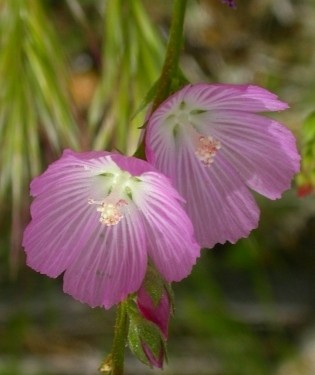Salt spring checkerbloom
(Sidalcea neomexicana)

Description
Sidalcea neomexicana is a species of flowering plant in the mallow family known by the common names salt spring checkerbloom, Rocky Mountain checker-mallow, and New Mexico checker. Sidalcea neomexicana is a perennial herb growing from a cluster of fleshy roots, the mostly hairless stem growing 20 to 90 centimeters tall. The fleshy leaves are sometimes divided shallowly to deeply into lobes. The inflorescence is a loose cluster of flowers with pink petals up to 2 centimeters long. The plant is native to the Western United States and northern Mexico. It can be found in a diverse number of habitat types, including chaparral and coastal sage scrub, Yellow Pine Forest and riparian zones, Creosote bush scrub, and alkali flats and other salty substrates. Sidalcea is a genus (approx. 25 species) of the botanical family Malvaceae. It contains several species of flowering plants known generally as checkerblooms or checkermallows, or prairie mallows in the United Kingdom. They can be annuals or perennials, some rhizomatous. They are native to West and Central North America. In mid- to late summer the clumps of toothed basal leaves produce erect flowering stems, with 5-petalled mallow-type flowers in terminal racemes, in shades of pink, white and purple. Sidalcea is generally diploid (2n = 20), but polyploidy (4n, 6n) also occurs. Annuality appears to have evolved multiple times (4+) within this genus, although an ancestral annual state with annual paraphyly is also possible. Further, evolution rates within annual Sidalcea lineages appear to be faster than those of perennial lineages, at least when examining nuclear ribosomal DNA (internal and external transcribed spacer regions).
Taxonomic tree:







